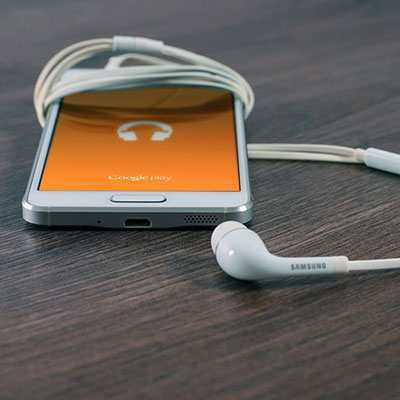
What’s the future of the music industry? Big question. And one we’ve attempted to answer a few times over the past year. Amidst talk of a revolution afoot, innovations in streaming and the growing importance of the live industry, it’s time to look at the facts. How do you listen to music? On your iPhone, probably, and that’s just about where you do everything else, right? Browse the internet, stalk people on social media, play games, check your email, take photos and watch videos. Every other industry has figured out a way to reach consumers via their phones, and, most importantly, make money through it too. The music industry has done the first part, but we’re still waiting on the second.

Though streaming is growing, there are still big questions over its viability to provide musicians with a significant income stream. While it does look like the model could be set for a shake-up this year, no one knows whether platforms like Spotify will provide a sustainable business model or not. But whoever got anywhere by waiting around? Artists need to take their destiny into their own hands, look at the tools that are available to them, and start building a business. Think of streaming like a marketing tool, an engagement platform that can be used to tempt fans into parting with real cash. It’s an idea that was championed by industry analyst Mark Mulligan at Eurosonic this year, as well as technology company Disciple Media, who’ve been busy building the tools to make it work. You’ll hear from both of them below, and discover how to truly unlock the potential of digital platforms.
Taylor made
Taylor Swift is one artist that seems to have got it right. The singer/songwriter pulled her catalog from Spotify last year ahead of releasing her latest album, 1989, because it didn’t offer a premium-only option. Her loyal fanbase still went out and bought the LP, which has sold around 8.6 million copies worldwide. So what does she do to keep that fanbase buying her music, instead of streaming it for free or downloading from piracy websites? She uses digital platforms to go that extra mile.Last Christmas, Swift followed a few of her fans on Twitter, Tumblr, and Instagram to find out what they were into. Based on their likes and dislikes, a lucky few got sent gifts, personally chosen and wrapped by Swift herself. Meanwhile, Beyonce’s YouTube channel features behind-the-scenes videos of performances, choreography, and playlists. “Vevo is used to host music videos, while the music on YouTube is more than the song. It’s about video, comments and social interactivity. It’s a music service that understands that experience is the product they are selling and gives it away for free,” adds Mulligan.
Next generation music products
“No mature subscription service in the world only sells you one product, but that’s what’s happening with music at the moment,” explains Mulligan. “Music aficionados used to spend £40 a month on music, now they’re spending £9.99. We’re essentially telling them, ‘Please spend less!’”. He’s got a good point; Sky offers multiple options for broadband, TV, and movie plans, while mobile phone plans have a wealth of add-ons. Mulligan proposes a premium of a few euros added on to subscription tariffs every month, which offer fans an “interactive experience.”Next generation music products need to be “dynamic, interactive, social and curated”. Says Mulligan: “Always change and update them with new content, place social functionality and connectivity at the core and give users a way to make sense of the 30 million songs at their disposal. They should add curated content to the music - experience is the product. 360 music products can leverage existing content assets to minimize additional artist burden, with the album at the core of the experience.”
Bespoke artist album apps
So what could these products look like in reality? It looks like Disciple Media have created a prime example. Headed up by electronic music mastermind Benji Vaughan (who releases music under the moniker Prometheus) and ex-Warner digital exec Leanne Sharman, the company launched their artist-branded apps earlier this year. The platform allows artists to publish content or live-stream directly to fans, aiming to provide an easy one-stop shop for artists to create exclusive fan experiences.A live-stream feature enables artists to send video content from their mobile phones or laptops by sending out a notification to their subscriber base. During the live broadcast, fans can also instant message each other and communicate directly with the artist. Other features include a music player, photo stream and options for exclusive merchandising and upfront access to tickets.
Fans can chose a free tier or pay a monthly subscription to unlock more content and greater access. There are three ways of creating revenue through the app, together with subscription fees, fans can buy one-off items through in-app purchases and artists can also team up with brands for a lifetime sponsorship of the app. Says Vaughan: “I would imagine the apps could create a lot more revenue than artists are generating in pure music downloads in a year. If you’re looking at an artist in the pop/EDM world with 50m+ followers, a 1% adoption rate creates huge revenue, and having that ownership of your fanbase is very powerful.”
The inspiration behind Disciple came from Vaughan’s experience as a touring artist and record producer, as well as partner in indie label [Twisted Records]. “The fanbase for our label was very keen to be interacting with us at all times and they wanted more than just purely social media. I was looking for a product that could engage my fanbase and couldn’t find it in the marketplace. I had two options at that point; either give up or build it myself.” YouTube, Vevo, Twitter, Facebook, Instagram and more, offer artists the tools to build their own interactive offerings. All you need is an engaged fanbase who likes what you do, and how you make the most of that is up to you.

Ready to get your music out there?
Distribute your music to the widest range of streaming platforms and shops worldwide.


